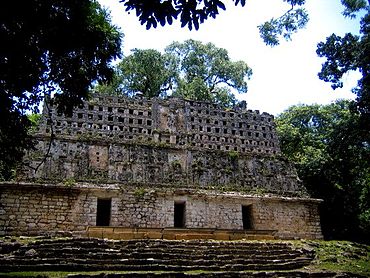Yaxchilan


Yaxchilan (ponekad navođen i kao Menché i Grad Lorillarda) je drevni majanski grad smješten na obali rijeke Usumacinta u današnjoj meksičkoj državi Chiapas. U kasnom klasičnom periodu Yaxchilan je bio jedna od najmoćnijih majanskih država duž rijeke Usumacinta, sa gradom Piedras Negras kao glavnim suparnikom.[1] Arhitektonski stilovi u podložnim gradovima/oblastima Usumacinte pokazuju jasnu granicu između dva kraljevstva.[1]
Yaxchilan je bio veliki grad i važno središte u klasičnoj eri. Dominirao je manjim gradovima kao Bonampak,[2] a uz dugogodišnje suparništvo sa Piedras Negrasom neko vrijeme je ratovao i sa Tikalom; također je bio suparnik Palenquea, sa kojim je Yaxchilan ratovao 654.
Danas se na mjestu grada nalazi niz prilično dobro sačuvanih građevina.[3] Na njima se nalaze natpisi koji, uz brojne stele, daju dobre podatke o historiji vladara grada.[3]
Drevno ime za grad je Pa' Chan. Današnje ime Yaxchilan znači "zeleno kamenje" na majanskom.
Napomene
Literatura

- Coe, Michael D. (1999). The Maya. Ancient peoples and places series (6th edition, fully revised and expanded izd.). London and New York: Thames & Hudson. ISBN 0-500-28066-5. OCLC 59432778.
- Cohodas, Marvin (1991). „Ballgame Imagery of the Maya Lowlands: History and Iconography”. u: Vernon Scarborough and David R. Wilcox (eds.). The Mesoamerican Ballgame. Tucson: University of Arizona Press. str. 251–288. ISBN 0-8165-1360-0. OCLC 51873028.
- De la Fuente, Beatriz (2001). Pintura Mural Prehispánica en México: Area Maya, Estudios 2001, IIEs, UNAM.
- Hammond, Norman (2000). „The Maya Lowlands: Pioneer Farmers to Merchant Princes”. u: Richard E.W. Adams and Murdo J. Macleod (eds.). The Cambridge History of the Native Peoples of the Americas, Vol. II: Mesoamerica, part 1. Cambridge, UK: Cambridge University Press. str. 197–249. ISBN 0-521-35165-0. OCLC 33359444.
- Kelly, Joyce (2001). An Archaeological Guide to Central and Southern Mexico. Norman: University of Oklahoma Press. ISBN 0-8061-3349-X.
- Martin, Simon; and Nikolai Grube (2000). Chronicle of the Maya Kings and Queens: Deciphering the Dynasties of the Ancient Maya. London and New York: Thames & Hudson. ISBN 0-500-05103-8. OCLC 47358325.
- Scarborough, Vernon L. (1991). „Courting in the Southern Maya Lowlands: A Study in Pre-Hispanic Ballgame Architecture”. u: Vernon Scarborough and David R. Wilcox (eds.). The Mesoamerican Ballgame. Tucson: University of Arizona Press. str. 129–144. ISBN 0-8165-1360-0. OCLC 51873028.
- Schele, Linda; and Matthew G. Looper (2005). „Seats of Power at Copán”. u: E. Wyllys Andrews and William L. Fash (eds.). Copán: The History of an Ancient Maya Kingdom. Santa Fe and Oxford: School of American Research Press and James Currey Ltd. str. 345–372. ISBN 0-85255-981-X. OCLC 56194789.
- Sharer, Robert J.; with Loa P. Traxler (2006). The Ancient Maya (6th (fully revised) izd.). Stanford, California: Stanford University Press. ISBN 0-8047-4817-9. OCLC 57577446.
- Taladoire, Eric; and Benoit Colsenet (1991). „"Bois Ton Sang, Beaumanoir": The Political and Conflictual Aspects of the Ballgame in the Northern Chiapas Area”. u: Vernon Scarborough and David R. Wilcox (eds.). The Mesoamerican Ballgame. Tucson: University of Arizona Press. str. 161–174. ISBN 0-8165-1360-0. OCLC 51873028.
- Tate, Carolyn E. (1992). Yaxchilan: The Design of a Maya Ceremonial City. Austin: University of Texas Press. ISBN 0-292-77041-3. OCLC 23464300.
16°54′N 90°58′W / 16.900°N 90.967°W / 16.900; -90.967






